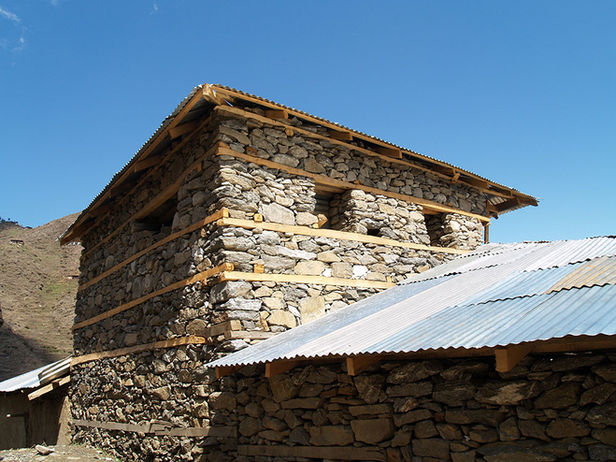Awareness raising material
Awareness raising material
Awareness raising material
Awareness raising material
Awareness raising material
seismico
%20copy2.jpg)
Bhatar / Hatıl
Bhatar is a Pashtoo word describing timber beams with cross sections of approximately 10 x 10 cm. By extension the word Bhatar stands for a building technique where ladder-like elements made out of such timber beams are placed into the stone walls at regular vertical intervals.
In Turkey the timber beams of the ladder-like reinforce-ments are called Hatıl. This technique has been used throughout the Ottoman empire, thus can frequently be found in Macedonia and other areas of the Balkans. Timber reinforced stone masonry does exist all around the Mediterranean where it is not only used to improve earthquake resistance of buildings but to contrast differential settlements on soft soils.
Reinforcing stone masonry with horizontal timber
elements to make them more fit to resist earthquakes is quite an old idea. In fact, traces of timber lacing have been found in Minoan palaces of Crete from 2500 BC.
The Cator and Cribbage technique typical of the Baltistan region of northern Pakistan is a closely related construction method. The corners are well defined by short stacked pieces of timber (cribbage) interlaced with the lengthwise timber beams embedded in the stone walls.
Finally, the continuous multiple layers of bricks in stone masonry used by the Romans and known as opus listatum, may have had a similar role as the timber reinforcements: providing continuity and coherence to the walls.









Manuals
Video
This shake table demonstration and video have been prepared by the Nepalese Society of Earthquake Technology NSET for the sensitization of the people of Muzaffarabad as part of their reconstruction training in the aftermath of the 2005 earthquake.
Pictures
Background documentation
Adhikari R.H. and D'Ayala D. (2020), 2015 Nepal earthquake: seismic performance and post-earthquake reconstruction of stone in mud mortar masonry buildings, in Bulletin of Earthquake Engineering, Springer
Carabbio R. et al (2018), How can Vernacular Construction Techniques sustain Earthquakes: the case of Bhatar buildings, Frontiers in Built Environments 4.18
Devaux Baudraz M. et al. (2014), Comportement sismique de la maçonnerie de type bhatar, Projet de semestre 3, Filière de génie Civil, Ecole d'ingénieur et d'architecte de Fribourg, Switzerland
Helvetas (2017?), Employment Fund "Skills for Reconstruction" - Building Back Better, Helvetas - SDC - UKaid - World Bank
Hughes R. (2000), Cator and Cribbage Construction of Northern Pakistan, Aga Khan Cultural Services
Hughes R. (2000), Hatil Construction in Turkey, International Conference on the Seismic Performance of Traditional Buildings, Istanbul, Turkey
Parajuli H.R. (2009), Dynamic Analysis of low-strength masonry houses based on site specific earthquake ground motion, Thesis, Kyoto University
Rautela Piyoosh et al. (2008), Timber-reinforced Stone Masonry (Koti Banal Architecture) of Uttarakhand and Himachal Pradesh, Northern India, Housing Report, World Housing Encyclopedia, EERI - IAEE
Sagiroglu Ö. (2016), Characteristics and Construction of Akseki Bucakalan Village Rural Dwellings, in International Journal of Architectural Heritage, Taylor & Francis
Sumanov L (2003), Transfer of Knowledge for saving human lives - Living Tradition: Use of Traditional Horizontal Timber Belts as Anti-Seismic Elements, 14th ICOMOS General Assembly, Victoria Falls, Zimbabwe
TEC21 (2011), Stabile Traditionen finden, in Bauen - Helfen - Lernen, TEC21, Zurich, Switzerland
Vintzileou E. (2010), Timber-reinforced structures in Greece: 2500 BC - 1900 AD, Institution of Civil Engineering, National Technical University of Athens, Greece




























